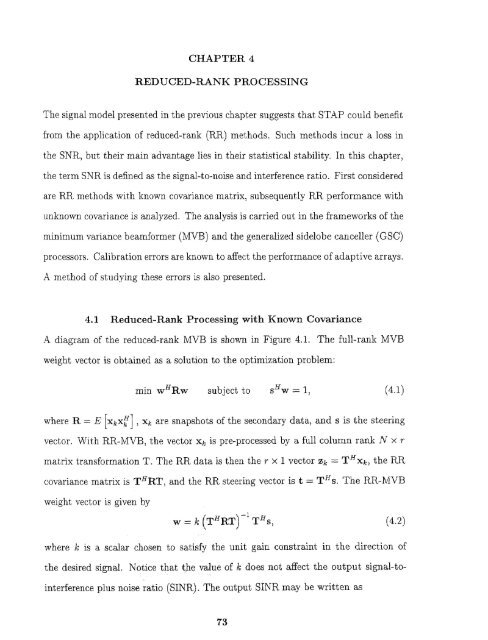Space/time/frequency methods in adaptive radar - New Jersey ...
Space/time/frequency methods in adaptive radar - New Jersey ...
Space/time/frequency methods in adaptive radar - New Jersey ...
You also want an ePaper? Increase the reach of your titles
YUMPU automatically turns print PDFs into web optimized ePapers that Google loves.
CHAPTER 4REDUCED-RANK PROCESSINGThe signal model presented <strong>in</strong> the previous chapter suggests that STAP could benefitfrom the application of reduced-rank (RR) <strong>methods</strong>. Such <strong>methods</strong> <strong>in</strong>cur a loss <strong>in</strong>the SNR, but their ma<strong>in</strong> advantage lies <strong>in</strong> their statistical stability. In this chapter,the term SNR is def<strong>in</strong>ed as the signal-to-noise and <strong>in</strong>terference ratio. First consideredare RR <strong>methods</strong> with known covariance matrix, subsequently RR performance withunknown covariance is analyzed. The analysis is carried out <strong>in</strong> the frameworks of them<strong>in</strong>imum variance beamformer (MVB) and the generalized sidelobe canceller (GSC)processors. Calibration errors are known to affect the performance of <strong>adaptive</strong> arrays.A method of study<strong>in</strong>g these errors is also presented.4.1 Reduced-Rank Process<strong>in</strong>g with Known CovarianceA diagram of the reduced-rank MVB is shown <strong>in</strong> Figure 4.1. The full-rank MVBweight vector is obta<strong>in</strong>ed as a solution to the optimization problem:are snapshots of the secondary data, and s is the steer<strong>in</strong>gvector. With RR-MVB, the vector xk is pre-processed by a full column rank N x rmatrix transformation T. The RR data is then the r x 1 vector zk THxk , the RRcovariance matrix is THRT, and the RR steer<strong>in</strong>g vector is t THs. The RR-MVBweight vector is given bywhere k is a scalar chosen to satisfy the unit ga<strong>in</strong> constra<strong>in</strong>t <strong>in</strong> the direction ofthe desired signal. Notice that the value of k does not affect the output signal-to<strong>in</strong>terferenceplus noise ratio (SINR). The output SINR may be written as73
















